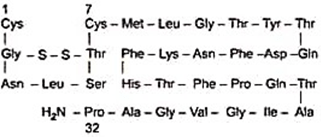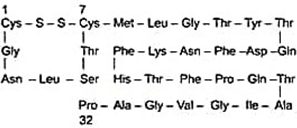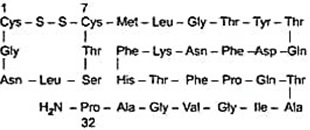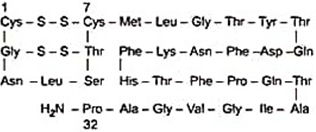This set of Molecular Endocrinology Multiple Choice Questions & Answers (MCQs) focuses on “Parathyroid Gland and their Hormones – Calcitonin”.
1. Which among the following hormones has a major role in calcium regulation?
a) Calcitonin
b) Parathormone
c) FSH
d) TSH
View Answer
Explanation: Calcitonin is the parathyroid hormone that helps in the calcium regulation. Parathormone is also involved in calcium metabolism. In comparison to the action of parathyroid hormone, calcitonin is involved in helping to control calcium and phosphate levels in the blood.
2. Which cells secrete calcitonin hormone in parathyroid, thyroid and thymus glands?
a) Acinar cells
b) C-cells
c) Alveolar cells
d) K-cells
View Answer
Explanation: Calcitonin has been proved to derive from special cells, called parafollicular “C-cells.” C-cells are an endocrine pathway originating from the “neural crest” in the thyroid, parathyroid, and thymus. Neuroendocrine cells in the thyroid are known as Parafollicular cells, which is also called C cells.
3. Which among the following is the correct amino acid sequence of human calcitonin?
a) 
b)

c)

d)

View Answer
Explanation: Calcitonin’s amino acid sequence comprises 32 amino acids, cysteine is the N-terminal amino acid, and prolinamide is the C-terminal amino acid. Two cystine residues between position 1 and position 7 are joined by an interchain disulfide bridge.
4. State whether True or False. Calcitonin operates on the bone as well as in the kidneys.
a) True
b) False
View Answer
Explanation: Kidneys and bone are the main target sites of calcitonin. Hypocalcemia and hypophosphatemia are indirectly due to the consequences of calcitonin in these two organ systems. Calcitonin reduces the amount of calcium in the blood by stopping the breakdown of bone. The hormone also tends to reduce the amount of calcium that can be re-absorbed by the kidneys, reducing its levels further.
5. Calcitonin prevents osteoclastic bone resorption.
a) True
b) False
View Answer
Explanation: Calcitonin prevents osteoclastic bone resorption and thereby reduces the recruitment of calcium and inorganic phosphate from the bones into the blood. It also promotes the entry of bone phosphates. The calcium found in the bone is released into the bloodstream as the bone breaks down. Thus, calcitonin inhibition of the osteoclasts directly reduces the amount of calcium that is released into the blood.
6. Which enzyme is inhibited by calcitonin in the kidney that reduces the absorption of calcium?
a) Beta-1-hydroxylase
b) Alpha-1-hydroxylase
c) Gamma-1hydroxylase
d) Beta-1-isomerase
View Answer
Explanation: Calcitonin inhibits alpha-1-hydroxylase and inhibits 1,25-di-OH-D3 synthesis, thus reducing the removal of calcium from the intestine. Hypocalcemia contributes to this process. Hypocalcemia is a condition in which the liquid component of the blood, or the plasma, has lower than normal levels of calcium.
7. Medullary carcinoma of thyroid is associated with which regulatory hormone?
a) Calcitonin
b) Parathormone
c) TSH
d) Vasopressin
View Answer
Explanation: There is now evidence for irregular calcitonin secretion in the case of “medullary thyroid carcinoma.” Medullary carcinoma is clinically comprised of a single cell and it has now been identified that this tumor originates from thyroid para-follicular C cells.
8. Which among the following diseases can be cured with the administration of calcitonin hormone?
a) Maple Syrup Urine Disease
b) Phenylketonuria
c) Jaundice
d) Paget’s disease
View Answer
Explanation: Calcitonin has many therapeutic actions. It can be administered to treat many diseases including Paget’s disease, Idiopathic hypercalcemia of infancy, hypercalcemia secondary to malignancies, hyperparathyroidism and vitamin D intoxication.
9. How do calcitonin take part in bone laying process?
a) Increasing osteoblastic cells
b) Increasing osteoclastic cells
c) Decreasing osteoblastic cells
d) Increasing both osteoblasts and osteoclasts
View Answer
Explanation: It is unclear whether or not calcitonin facilitates bone formation. But it has been identified that the hormone raises osteoblast cells, which are believed to be involved in bone laying, in addition to inducing a reduction in the number of osteoclasts.
10. Where is the site of action of calcitonin in the kidneys?
a) Convoluted tubule
b) Distal tubule and ascending limb of Loop of Henle
c) Nephrons
d) Medulla
View Answer
Explanation: Calcitonin operates on the ascending limb of Loop of Henle and distal tubules. And then it decreases the reabsorption of calcium and phosphate which results in calcinuria and phosphaturia. In chronic renal failure, plasma levels of immunoreactive calcitonin are high.
Sanfoundry Global Education & Learning Series – Molecular Endocrinology.
To practice all areas of Molecular Endocrinology, here is complete set of 1000+ Multiple Choice Questions and Answers.
If you find a mistake in question / option / answer, kindly take a screenshot and email to [email protected]
